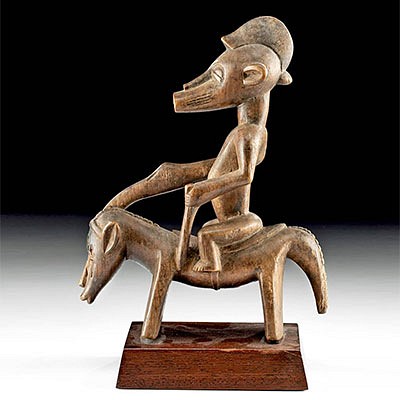Ancient Tongan Lapita Stone Adze
Lot 213
About Seller
Artemis Fine Arts
686 S Taylor Ave, Ste 106
Louisville, CO 80027
United States
Selling antiquities, ancient and ethnographic art online since 1993, Artemis Gallery specializes in Classical Antiquities (Egyptian, Greek, Roman, Near Eastern), Asian, Pre-Columbian, African / Tribal / Oceanographic art. Our extensive inventory includes pottery, stone, metal, wood, glass and textil...Read more
Categories
Estimate:
$1,000 - $1,500
Absentee vs Live bid
Two ways to bid:
- Leave a max absentee bid and the platform will bid on your behalf up to your maximum bid during the live auction.
- Bid live during the auction and your bids will be submitted real-time to the auctioneer.
Bid Increments
| Price | Bid Increment |
|---|---|
| $0 | $25 |
| $300 | $50 |
| $1,000 | $100 |
| $2,000 | $250 |
| $5,000 | $500 |
| $10,000 | $1,000 |
| $20,000 | $2,500 |
| $50,000 | $5,000 |
| $100,000 | $10,000 |
| $200,000 | $20,000 |
About Auction
By Artemis Fine Arts
Feb 17, 2022
Set Reminder
2022-02-17 10:00:00
2022-02-17 10:00:00
America/New_York
Bidsquare
Bidsquare : CLEARANCE | Ancient & Ethnographic Art
https://www.bidsquare.com/auctions/artemis-gallery/clearance-ancient-ethnographic-art-8898
Join us for our first clearance sale of the year featuring discounted pricing and many new items! Asian art, Classical antiquities from Egypt, Greece, Italy, and the Near East...plus Pre-Columbian, Tribal, Spanish Colonial, Fine Art, Fossils, more! Artemis Fine Arts info@artemisgallery.com
Join us for our first clearance sale of the year featuring discounted pricing and many new items! Asian art, Classical antiquities from Egypt, Greece, Italy, and the Near East...plus Pre-Columbian, Tribal, Spanish Colonial, Fine Art, Fossils, more! Artemis Fine Arts info@artemisgallery.com
- Lot Description
**First Time At Auction**
West Polynesia, Tonga Island, Lapita Culture, ca. 1600 to 500 BCE. A fine atone adze, skillfully hand-sculpted with smooth surfaces boasting shades of mottled charcoal and ash gray with burnt sienna and cream-colored inclusions. The ancient implement displays a quadrangular form with a wide, flat butt and smooth body that tapers to a slender, curved blade. Stone adzes, like this example, were not only used as tools and perhaps ceremonial objects, but also were an important status good to the early Polynesian people and were often specifically made for high-ranking members of society, serving as symbols of their power and prestige. As such, adzes were frequently gifted to chiefs of different tribes and preserved over generations. Size: 5.6" L x 2.6" W (14.2 cm x 6.6 cm)
The Lapita peoples originated in Taiwan and other regions of East Asia. As seafaring explorers and colonists, they settled on the Bismarck Archipelago (northeast of New Guinea) by 2000 BCE, and by 1600 BCE they also ventured to the Solomon Islands, reaching Fiji, Tonga, and other parts of western Polynesia by 1000 BCE. By 500 BCE they migrated to Micronesia.
Provenance: private Newport Beach, California, USA collection, ex Mauna Kea Gallery, Hawaii
All items legal to buy/sell under U.S. Statute covering cultural patrimony Code 2600, CHAPTER 14, and are guaranteed to be as described or your money back.
A Certificate of Authenticity will accompany all winning bids.
PLEASE NOTE: Due to recent increases of shipments being seized by Australian & German customs (even for items with pre-UNESCO provenance), we will no longer ship most antiquities and ancient Chinese art to Australia & Germany. For categories of items that are acceptable to ship to Australia or Germany, please contact us directly or work with your local customs brokerage firm.
Display stands not described as included/custom in the item description are for photography purposes only and will not be included with the item upon shipping.
#160897Repaired from 2 pieces with break lines visible. Areas of loss to butt. Some chipping to cutting edge and peripheries. A few minor nicks in areas. Otherwise, excellent with smooth surfaces. Collection label on 1 side.Condition
- Shipping Info
-
All shipping is handled in-house for your convenience. Your invoice from Artemis Gallery will include shipping calculation instructions. If in doubt, please inquire BEFORE bidding for estimated shipping costs for individual items.
-
- Buyer's Premium



 EUR
EUR CAD
CAD AUD
AUD GBP
GBP MXN
MXN HKD
HKD CNY
CNY MYR
MYR SEK
SEK SGD
SGD CHF
CHF THB
THB













